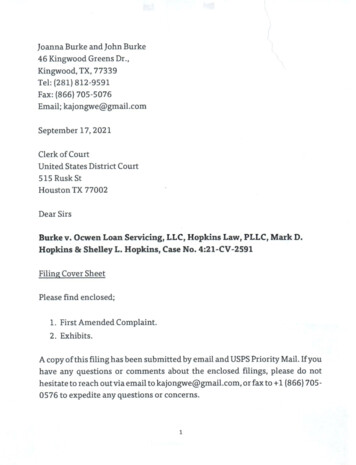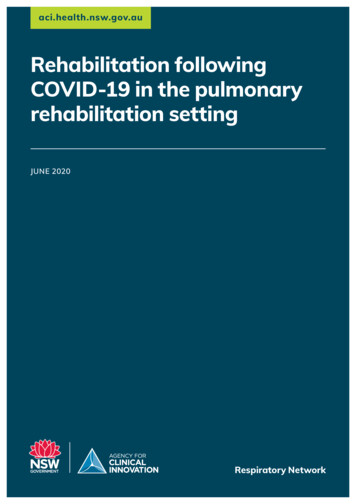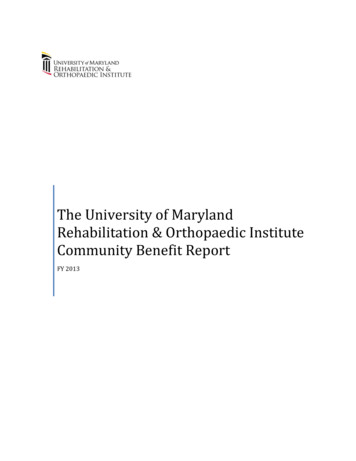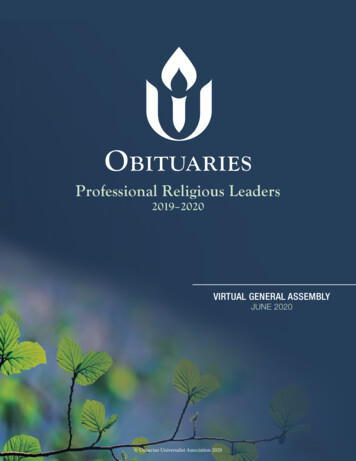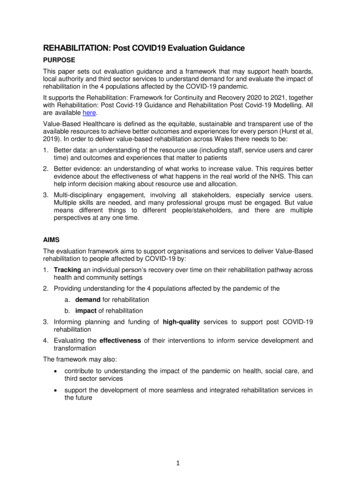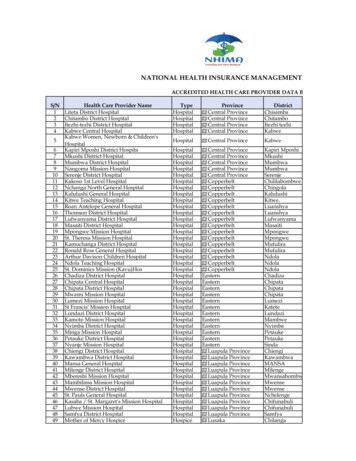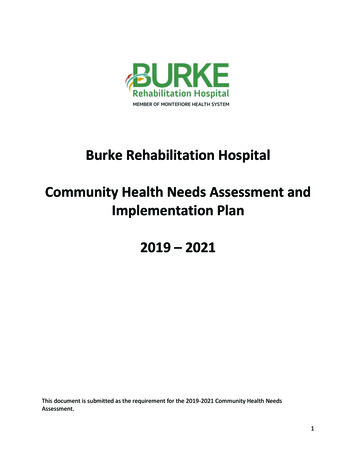
Transcription
Burke Rehabilitation HospitalCommunity Health Needs Assessment andImplementation Plan2019 – 2021This document is submitted as the requirement for the 2019-2021 Community Health NeedsAssessment.1
Table of ContentsSection 1: Executive Summary . 4Section 2: Introduction . 15a.Organizational Background . 15b.Statement of Executive Review . 17c.Availability of Report to the Public . 17d.Feedback from the Community . 18Section 3: Definition and Description of the Community/Service Area . 18a.Service Area . 18b.Community Description . 20c.Regional Health Disparities . 21d.Medically Underserved/HSPA Designation . 24e.Unique Characteristics . 26i.Local Government . 26ii.Local Health Department . 26iii.Healthcare Facilities . 27iv.Community-Based Organizations . 27v.Outdoor Space . 27vi.Tourism and Colleges . 28Section 4: Community Health Needs Assessment Process . 28a. CHNA Process/Methods . 28b. Secondary Data Review . 30c. Primary Data Collection. 34Section 5: Data Presentations . 36a. Primary Data Results . 36b. Secondary Data Results. 42Section 6: Implementation Strategy . 71a. Prevent Chronic Disease . 72b. Promote a Healthy and Safe Environment . 78c. Significant Health Needs Identified . 83i.Mental Health . 84ii.Food and Nutrition . 86Burke Rehabilitation Hospital CHNA 2019-2021Page 2
iii.Chronic Disease Screening and Care . 86iv.Physical Activity, Obesity and Environments that Promote Well-Being and Active Lifestyle. 87v.Child and Adolescent Health . 87vi.Significant Actions for Community . 87d.Impact of Previous CHNA . 126e.External Resources and Links . 127AppendicesACommunity Health Survey, EnglishBCommunity Health Survey, SpanishBurke Rehabilitation Hospital CHNA 2019-2021Page 3
Section 1: Executive SummaryAbout BurkeBurke Rehabilitation Hospital is a 150-bed, not-for-profit acute rehabilitation hospital located in WhitePlains, New York in Westchester County. Founded in 1915 through an endowment from philanthropistJohn Masterson Burke, it is the only hospital in Westchester County dedicated solely to adultrehabilitation medicine. Burke became a member of the Montefiore Health System in 2016.Burke offers both inpatient and outpatient programs for individuals who have experienced a disablingillness, traumatic injury or surgery. The hospital’s renowned physicians, therapists, nurses and supportstaff provide state-of-the-art treatment and all share the Burke mission to ensure that every patientmakes the fullest possible recovery.In addition to medical rehabilitation services, Burke Rehabilitation Hospital offers community events andeducation, adaptive sports programs and a three-year Accreditation Council for Graduate MedicalEducation (ACGME)-accredited Physical Medicine & Rehabilitation residency program. Burke’s inpatienthospital, outpatient therapy and outpatient physician practice are located on its main campus in WhitePlains, New York, and it has a network of eight additional outpatient therapy locations throughoutWestchester County and the Bronx.About the CommunityBurke Rehabilitation Hospital has identified Westchester County as its primary service area. As the onlyacute rehabilitation hospital in the county, Burke serves the needs of patients from any and all ofWestchester’s municipalities. Westchester County has a population of 975,321 and is approximately430.5 square land miles. Westchester is the 3rd healthiest county in New York State, according to theCounty Health Rankings produced by the University of Wisconsin.Burke Rehabilitation Hospital CHNA 2019-2021Page 4
According to the 2017 American Community Survey, Westchester County has experienced a 5.6%increase in population between 2000 and 2017. There are over 345,855 households in Westchester, ofwhich 33.8% are family households with children. Of the family households with children, 23.9% aresingle-headed households. Westchester has a slightly older population than New York State overall, witha median age of 40.6 years versus 38.4 years.Westchester’s population is 55.9% non-Hispanic white, 18.8% Hispanic, 14.4% non-Hispanic black, 8.3%Asian/Pacific Islander and 2.3% non-Hispanic other. The median household income is 89,968, wellabove the statewide value ( 62,765). Countywide, 9.4% of the population lives in poverty. Of note,11.7% of county children live below poverty. A similar proportion of the county’s population is publiclyinsured as compared to the state, but a higher proportion are uninsured.While Westchester remains among the healthiest counties in New York State, several of its individualmunicipalities continue to have significant health gaps. Portions of lower Westchester, specificallyMount Vernon, Yonkers, New Rochelle and White Plains are “hot spots” for various health outcomes,such as asthma and preterm births. Additionally, certain groups, such as some racial/ethnic minorities orthose with less education, experience poorer health outcomes. Secondary health data is presented insections 3 and 4 of this report.Community Health Needs Assessment ProcessThe process for preparing the 2019-2021 Community Health Needs Assessment was an interorganizational and community collaborative process, with the goal of developing an assessment thatwas reflective of the needs of the community including the clinical and social determinants of healthwhile aligning with the New York State Prevention Agenda priority areas. The survey was crafted byrepresentatives from all of the Westchester hospitals and staff at the Department of Health so that theBurke Rehabilitation Hospital CHNA 2019-2021Page 5
main themes that would emerge would be related to the priority areas and would identify which ofthose priority areas were of greatest concern to community members.A Community Health Needs Assessment should accurately depict two types of health concerns; those atthe community level and those on the personal level. This was taken into account when the survey wasdeveloped, and it was designed to capture health priority issues for the individual as well as for theircommunity as a whole. The methodology also included hearing from the side of community-basedorganizations in Westchester. These providers could report on themes that they see with their clients ortarget populations that those individuals may not recognize as priority health concerns that exist in thelarger community. Combining the perspectives of community members and their providers was aimedat ensuring an accurate a depiction of the health concerns of Westchester County.The personnel involved in conducting the community health needs assessment include a group of staffmembers representing each of the local Westchester hospitals and the Westchester County Departmentof Health staff who met monthly to develop the survey tool. Premier, a consultant company that wasbrought on to conduct the qualitative focus group portion of the CHNA, conducted the communitybased organization summit and provided a detailed report of the findings.For Burke, the prioritization of health needs was a result of analysis of primary and secondary data, aswell as institutional priorities and capacity. Key members of leadership that participated include thePresident & CEO, Chief Medical Officer, Assistant Chief Medical Officer, Vice President of Post-AcuteServices, Vice President of Inpatient Rehabilitation and Vice President, Development and Marketing.Primary Data CollectionBurke Rehabilitation Hospital collaborated with the Westchester County Department of Health andother Westchester hospitals to conduct a survey of county residents to determine their individual andcommunity health priority issues and needs. This survey was distributed to residents of WestchesterBurke Rehabilitation Hospital CHNA 2019-2021Page 6
county between January and April of 2019 through a grassroots effort in paper and digital format. Thesurvey was available in English and Spanish, and made available in other languages upon request.For this CHNA cycle, there was more emphasis on collecting surveys from a true cross section of thecounty. To that end, the Department of Health deployed volunteers to specific zip codes that wereunder-represented in the 2016-2018 CHNA due to low survey response rate. The survey was alsodeveloped in 2018 so that it was ready for deployment in January of 2019 so that the data could becollected as soon as permitted. This allowed all of the local hospitals and the health department to havedetailed results of the CHNA early enough in the year to use them meaningfully in determining whichhealth needs to address.Primary data was also collected from Westchester community-based organizations through the inperson focus group summit. The summit was comprised of over 70 representatives from communitybased organizations attending breakout sessions focused on the Prevention Agenda priority areas:Chronic Disease, Safe Environment, Women, Infants and Children and Mental Health and SubstanceAbuse. Many of the themes that were reported from the summit include more education andcollaboration throughout the county. It was noted that there are resources available for many of thehealth issues, but, knowledge of them and coordination across all entities is lacking.Primary Data ResultsA total of 3,524 completed surveys were collected from the Westchester community survey. Thequestions in the survey were tailored to align with the prevention agenda priority focus areas.Respondents were asked to identify three areas of priority health issues in the community where theylive, three actions that would be most helpful to improve the health of the community where they live,and three areas of priority health issues for themselves. The results of these three questions werepresented in ranked order. Other questions were related to the individual’s personal health status andBurke Rehabilitation Hospital CHNA 2019-2021Page 7
needs, including health status rating, healthcare providers and visits and insurance. The final section ofthe survey collected demographic information.Based on the survey results, the top priority health issues in the community were identified as mentalhealth, chronic disease screening and care and food and nutrition. The top helpful actions for thecommunity were identified as affordable housing, mental health services and exercise and weight lossprograms. The top priority health issues for the individual were identified as food and nutrition, physicalactivity and environments that promote well-being and active lifestyles.Following the distribution of the survey, the community-based organization focus group providedqualitative data to contextualize the quantitative survey results. Overall, participants felt that there aremany strengths and existing resources in the community, but that there could be stronger connectionsand collaborations to best leverage these existing programs. Communication among local resources andorganizations is key to having a positive impact in each of the priority areas.Gaps that were identified include a lack of education at a young enough age, targeting Westchester’schildren and adolescents with education and training for healthy behaviors, a lack of culturally specificguidance and messaging, and overall a sense of fragmented communication across the community.Barriers that exist within the county for community members to take advantage of resources include alack of safe environments for persons seeking help. While it was identified that there are, in fact, manyresources currently, there may be a lack of understanding and aligning of them.Specific actions identified which all priority areas would benefit from include utilizing social media foreducation, increased awarenes and communication, improving transitions and coordination acrosscontinuum of providers, and embracing person-centric language that is universal to all to both increaseawareness and reduce stigma for some of the very common health needs such as mental health,substance abuse, reproductive health, domestic violence and more. When creating and collaborating onBurke Rehabilitation Hospital CHNA 2019-2021Page 8
resources, including the categories of provider, family and caregiver could help to provide newperspectives and help build assets and programs that are truly benefitting all. Finally, it is most effectiveto start by focusing on meeting basic needs before trying to address other more overarching andcreative needs.Secondary DataSecondary data specific to Burke as well as at the county and state-wide level was reviewed whenassessing the needs of the community. We evaluated socio-demographically similar counties, and subcounty differences, when available, for more than twenty measures, including: obesity, preterm births,teen pregnancy rates, poverty, preventable hospitalizations, access to primary care, insurance status,smoking, flu immunizations, cancer screening, HIV incidence, lung, colorectal, prostate and breastcancer incidence rates, and hospitalizations for asthma, diabetes, assaults, heart attacks and falls. Datawas also collected on the top twenty inpatient discharges from Burke Rehabilitation Hospital. Thesecondary data sources are detailed in sections 4.b. and 5.b. of this report, and figures illustrating healthdisparities throughout the county are included.Implementation StrategyBurke Rehabilitation Hospital’s specialty rehabilitation programs and services differ from those providedat the other Westchester hospitals, and this fact contributed to which priority areas Burke would select.The results of the Westchester survey align with Burke’s selection of prevent chronic disease as one ofits priority areas. The second priority area that was selected was based on the population that Burkeserves, and where the hospital has the capacity to have a large impact. In 2018, Burke’s averageinpatient age was 69 years old and 68.9% of 2018 inpatients were age 65 or older, and the averageoutpatient age was 63 years old and 54.83% of outpatients were age 65 or older. In WestchesterCounty, 16% of the population is 65 years or older according to the American Community Survey 20132017, so Burke’s patient population does not reflect the age demographics of the county. Based on thisBurke Rehabilitation Hospital CHNA 2019-2021Page 9
information, Burke chose a priority area related to the skew of vulnerable elderly population it servesand selected promote a healthy and safe environment.Prevent Chronic DiseaseThe first priority area Burke has chosen to continue to work on is prevent chronic disease, since it isimportant to both the population of Westchester County as a whole based on the survey results, andthe patients and community members Burke serves in its programs. Burke has selected focus area 2:physical activity, which aligns with what Burke’s service area community members identified second aspriority health issues for themselves individually. In addition, exercise and weight loss programs wereidentified as the fourth highest helpful actions for the Westchester community. Environments thatpromote active lifestyles was also a theme which appeared in the top five priority health issues for boththe individual and the community.Burke has selected goal 2.3: increase access, for people of all ages and abilities, to indoor and/oroutdoor places for physical activity. Not only will this help address the needs of Burke’s patients whorequire ongoing maintenance to prevent secondary strokes and cardiovascular events, among otherchronic health conditions, but resources along Burke’s continuum of care are available to members ofthe community of all ability levels. Burke will work towards objective 1.14: increase the percentage ofadults age 65 years and older who meet the aerobic and muscle strengthening physical activityguidelines by 10% from 16.4% (2015) to 18.0%.In alignment with intervention 2.3.1., Burke’s Adult Fitness Center offers evidence-informed individualand group programming in a safe and supportive environment. Exercise plans and classes are designedbased on the American College of Sports Medicine guidelines. Fitness center members have the optionto have individualized exercise plans designed for them by certified trainers based on their medicalhistory, fitness level and goals. These workouts can be tracked in the MyWellness system and can beBurke Rehabilitation Hospital CHNA 2019-2021Page 10
adjusted and reported. A variety of group exercise classes are available, including some specifically forindividuals with medical impairments such as Fit for Life for Parkinson’s, Pulmonary, Strength &Conditioning and Stroke.Burke has internal partners that serve as referral sources for the fitness center. Burke’s outpatientphysical therapy department as well as the cardiac rehabilitation program provide referrals forindividuals who could benefit from enrolling in the fitness center once they have completed theirprogram. Burke also receives referrals from external physicians for their patients to join the FitnessCenter as a member and/or participate in specialized classes. Burke also partners with organizationssuch as Westchester Tai Chi and other consultants and members of Burke’s clinical staff, such asrecreational therapists, to provide fitness instructors for the classes.Burke will also partner with local organizations to share information about the availability andprogramming available at the Adult Fitness Center. This will include educational presentations on thehealth benefits of physical fitness: the importance of it at any ability level and the potential adaptationsavailable, education for local physicians who will refer their patients and partnering with localcorporations to provide education and fitness plans for their employees. This education will aim tobridge the communication gaps identified by the community-based organizations.In order to track progress, Burke will measure the number of adults age 65 and older who areparticipating in Adult Fitness Center programming that meets the physical activity guidelines. Thisincludes attending classes or completing individualized exercise in the open gym. Burke will also trackthe number of educational events held throughout the year and the number of attendees.Promote a Healthy and Safe EnvironmentNew to Burke’s community service plan for 2019-2021 is the selection of priority area: promote ahealthy and safe environment. In order to make a difference and lower the amount of preventableBurke Rehabilitation Hospital CHNA 2019-2021Page 11
injuries that may occur during or after a hospital stay, Burke has chosen focus area 1: injuries, violenceand occupational health. The high population of adults age 65 and older that are Burke patients is avulnerable population is at risk for hospitalizations due to falls both when they are in the hospital andwhen they have returned home. Attendees at Burke’s events also tend to fall in this age demographic.According to the data obtained at the community-based organizations summit, frail and elderlyindividuals are at risk for a variety of challenges, including fall-related injuries, and addressing theseissues was identified as high importance among the attendees. Falls risk reduction is a high priority forstaff at all levels of Burke, from leadership to the clinical patient care team. Resources already are, andwill continue to be allocated to this initiative as part of Burke’s focus on patient safety. To that end,Burke has selected goal 1.1: reduce falls among vulnerable populations. Because of the differencebetween the age demographic breakdown of Burke patients and the age breakdown of the communityof Westchester, Burke is servicing many of the members of the community’s vulnerable elderlypopulation and can make a true impact on their health.The outcome objective that Burke will be working towards is 1.1.b.: Decrease the annual rate ofhospitalizations due to falls among residents ages 65 and over by 5% to 170.1 per 10,000 residents(Baseline 179.9 in 2016. Data Source: SPARCS; Available Date: State/County Level). In alignment withinterventions 1.1.2: promote health care provider screening for fall risk among older adults and peoplewith disabilities and engage health care providers in identifying modifiable risk factors and developing afall prevention plan of care, and 1.1.4: integrate exercise and fall prevention activities into physical oroccupational therapy, Burke will utilize evidence-based falls risk reduction and fall prevention programsand screening tools.All patients will be screened upon admission to the inpatient hospital to identify their fall risk. Burkeincorporates balance work into nearly every single patient’s therapy program, as balance is a keyBurke Rehabilitation Hospital CHNA 2019-2021Page 12
function in regaining independence – whatever the level. When a patient has been identified as a highfall risk, balance work is incorporated at a higher level into their physical and occupational therapyactivities.Balance testing and fall risk screening will also be available to members of the community at freecommunity events and presentations. Burke will continue to provide educational presentations andscreenings to external groups on how to reduce fall risk, the dangers of falls and how to improvebalance. This can include assessing the individual as well as their home environment. Finally, Burke willcontinue to refine the fall reporting tools and processes at the hospital to improve patient outcomes asthey relate to falls.Burke will also partner with a number of community-based organizations, external groups, healthcarefacilities and corporations to provide screenings and education on falls risk. Burke is looking to buildupon these partnerships with other local assisted living facilities, local organizations and communitygroups. Specifically, for this cycle, Burke will build upon the education it has done in the past to move toperforming screenings as well.To assess Burke’s progress, the hospital will measure the number of adults age 65 and older who receivea BERG balance scale assessment or other falls risk screening tool, both in the community and aspatients. Burke will also track the number of attendees at educational events that provide informationin reducing fall risk. Currently, Burke offers these screenings at annual events such as BalanceAwareness Day, and will continue to do more events and build more partnerships to create morescreening opportunities.Significant Health Needs IdentifiedThe Community Health Needs Assessment provided the significant health needs that WestchesterCounty residents identified in three formats: priority health issues for the community, priority healthBurke Rehabilitation Hospital CHNA 2019-2021Page 13
issues for them as individuals, and most helpful actions for the community. In order of highest rankedneed, the top health issues for the community were identified as: mental health, chronic diseasescreening and care, food and nutrition, obesity and environments that promote well-being and activelifestyle. In order of highest ranked need, the top health issues for individuals were identified as: foodand nutrition, physical activity, environments that promote well-being and active lifestyle, chronicdisease screening and care and mental health. In order of highest ranked action, the top most helpfulactions for the community were identified as: affordable housing, mental health services, access tohealthier food, exercise and weight loss programs and employment opportunities.In sections 5.c.i. through 5.c.vi. of this report, there are details about resources that Burke may currentlyallocate to this significant heath need even if it is not a priority area that was selected for the cycle, orother internal Montefiore Health System resources that are available that Burke refers individuals to.Being a member of a larger health system opens Burke patients and event attendees up to a largeamount of health system and established community resources they can benefit from.Community members who wish to provide written feedback on the Community Health NeedsAssessment for 2019-2021 should send it to the attention of:Lindsay FenetyManager, Community RelationsBurke Rehabilitation Hospital785 Mamaroneck AvenueWhite Plains, NY 10605Email: lfenety@burke.orgPhone: (914) 597-2871This report was produced by the marketing department, and reviewed and approved by Burke’sPresident & CEO. This report was submitted, reviewed and approved by the Burke RehabilitationHospital Board of Trustees at the Board meeting on Thursday, November 21, 2019.Burke Rehabilitation Hospital CHNA 2019-2021Page 14
Section 2: Introductiona. Organizational BackgroundBurke Rehabilitation Hospital is a 150-bed, not-for-profit acute rehabilitation hospital located in WhitePlains, New York in Westchester County. Founded in 1915 through an endowment from philanthropistJohn Masterson Burke, it is the only hospital in Westchester County dedicated solely to adultrehabilitation medicine. Burke became a member of the Montefiore Health System in 2016.Burke offers both inpatient and outpatient programs for individuals who have experienced a disablingillness, traumatic injury or surgery, including stroke, spinal cord injury, traumatic brain injury,cardiopulmonary diseases, orthopedic surgery, neurological conditions and movement disorders. Theseservices include physical, occupational, speech, recreational and specialty therapies, physician diagnosisand treatment, nutrition services and neuropsychology. Burke serves patients from Westchester and themetropolitan New York area, as well as throughout the Eastern United States and around the world. Thehospital’s renowned physicians, therapists, nurses and support staff provide state-of-the-art treatmentand all share the Burke mission to ensure that every patient makes the fullest possible recovery fromillness or injury.Burke's inpatient hospital is located on its main campus at 785 Mamaroneck Avenue in White Plains,New York. The Burke/Montefiore outpatient physician practice also operates on this campus, as well asone of Bur
Burke Rehabilitation Hospital has identified Westchester County as its primary service area. As the only acute rehabilitation hospital in the county, Burke serves the needs of patients from any and all of Westchesters municipalities. Westchester ou nty has a population of 975,321 and is approximately 430.5 square land miles.
